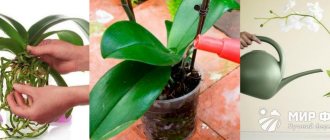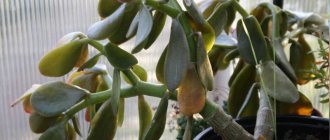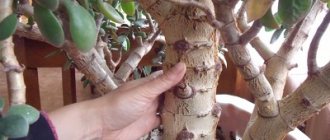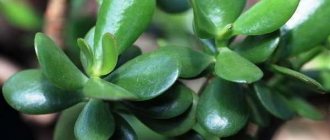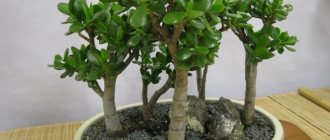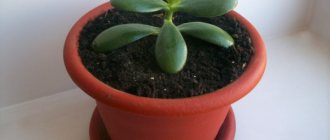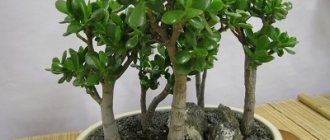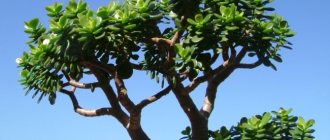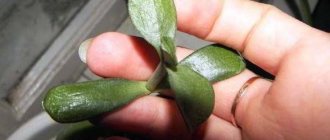One of the popular houseplants in Russia is Crassula, better known as the money tree. Its dense, round, plump leaves are very similar to coins. In addition to decorating the interior, it is believed that a tree grown with love can bring good luck and financial well-being to the home.
Crassula is generally an unpretentious plant; caring for the tree is not difficult even for novice gardeners or those who are always busy. The main and basic element of caring for a fat plant at home, ensuring its health and successful growth, is proper watering. Feeding is carried out with special mixtures once every half month and only in the summer, when the plant is actively developing.
Features of watering
The more magnificent the crown of a tree and the fleshier its leaves, the more actively the well-being of the family grows - this is what followers of Feng Shui believe. In addition, the abundant foliage of Crassula neutralizes negative energy. Correct and timely watering, carried out with a good attitude and love, can turn a young sprout into a full-fledged money tree.
This plant, like any living organism, has its own requirements for water quality. For example, its root system does not tolerate watering with cold tap water. Before moistening the soil in the pot, you should let the water settle and warm up to room temperature. It should be stored in an open container to allow the chlorine added to tap water to evaporate. Watering with melt water obtained by freezing in the freezer and then thawing will have an even better effect on the health of the flower - this way chemical impurities harmful to plants are removed from it.
Watering a money tree with a watering can
Watering the plant should be very moderate; it is recommended to do it from a watering can with an elongated spout; the water should flow slowly, without forming puddles in the root zone. If liquid seeps into the tray under the pot, it should be dried with a rag (and not left to soak back, as is done for other indoor flowers) a couple of tens of minutes after watering.
Additional Information. After moistening, the top layer of soil must be loosened to supply the roots with air.
The second way to water a money tree is to supply water through a tray in several passes until the substrate is completely saturated. At the same time, it is necessary to ensure that excess moisture does not remain in it, otherwise the roots may begin to rot.
Watering Crassula at different times of the year
How to propagate a Money Tree at home
In order for the tree of wealth to always be lush and pleasing to the eye, the conditions and intensity of watering should be differentiated depending on the time of year.
Being an African native and a genus of succulents, the money tree, with the help of its leaves, twigs and main trunk, can store large amounts of moisture in order to use it up little by little during dry periods. Therefore, for the health of the fat woman, insufficient hydration is easier to tolerate than its excess.
Watering a money tree through a tray
During the cold period, the plant begins to rest. You have to refrain from watering the “poor flower” one more time, even if the soil near the trunk seems completely dry.
When spring comes, the money tree, like most plants, begins to actively flow sap, it begins to grow and actively form new leaves. During this period, it is necessary to increase the number of waterings, depending on the growing conditions and the type of fat plant.
The fat woman can go without water for quite a long time; under no circumstances should it be watered daily. Two waterings a week are enough, and even less in the cold season (the required minimum is a couple of times a month). However, it is necessary to focus primarily on the state of the soil substrate in the pot for each specific plant: is it dry or still wet. Ideally, it should remain moist in the middle and dry in the upper layers.
How often to water a money tree in summer
How often does a money tree need to be watered in the summer? Many inexperienced indoor flower lovers believe that at this time the plant should be watered as often as possible. However, it is advisable to limit the amount of moisturizing to a couple of times every ten days.
In summer, the money tree is watered more often
It is necessary to monitor the condition of the soil substrate in the root zone, because it may be dry while the soil underneath is still moist. If you start watering the money tree again, the roots may rot, because they are very sensitive to excess moisture.
Important! If a plant nevertheless begins to lose foliage in the hot summer due to rotting of the roots, it can be revived by removing the dead parts and replanting it in a dry substrate, gradually moistening it to the entire depth of the pot.
Watering in autumn-winter
After the hot summer, it is advisable to keep the soil in containers where the money tree grows dry. Watering is done once a week, because autumn is considered to be the plant’s preparation for wintering, with sap flow slowing down and entering a state of dormancy.
In winter, the frequency of moistening the substrate is significantly reduced. If the tree overwinters at room temperature, in a warm place, it is enough to give it water once a month. If the plant is in a cool room during this period, you don’t have to water it at all.
There is almost no need to water the money tree in winter.
At this time of year (from November to March), the flower rests and gains strength for the new season. At the end of winter, the fat plant is again transferred to warm conditions and watered more often.
If the plant is cared for in this way, the green pet will actively grow a fleshy green mass of leaves - “coins”.
How much water does Crassula need?
Crassula tolerates drought well and differs from most indoor plants in its low water requirement. It is necessary to make adjustments to the watering regime, since the rate of moisture evaporation is influenced by many factors, including the size of the pot, its material, soil composition, etc.
There are signs by which it is easy to understand whether Crassula has too little or too much water, increase the hydration rate or decrease it.
Signs of Deficiency
During drought, the cells, abundantly filled with water, give it to the plant. When the reserves are used up, the cells shrink and become smaller. The leaves also decrease accordingly; they become limp, wrinkled, soft and dull. From this sign it is easy to understand that the plant is experiencing water deficiency.
The problem is easy to solve; you can restore your water balance in a couple of days. The leaves will freshen up, become elastic, juicy and glossy. Watch the crassula closely, it will itself signal that it needs water. Lack of moisture can also be determined by the lower leaves - they wrinkle.
Signs of excess
If Crassula easily survives drought and quickly recovers, then waterlogging usually becomes fatal for it - the plant dies.
This occurs due to the rupture of reservoir cells overflowing with water. Due to cell damage, rotting of roots and leaves occurs. When the roots rot, it cannot receive moisture, the leaves begin to change.
Signs of excess moisture:
- leaves become colorless, half transparent;
- the leaves lose their elasticity, they feel soft and watery;
- signs of tissue death appear on the leaves.
Leaves, having reached the state described above, can no longer recover. The plant sheds them. In this case, it is extremely difficult to save the tree. It all depends on the degree of damage.
What to do in case of overflow?
If, based on external signs, it has been established that the tree has suffered from overwatering - excess moisture, rescue should begin with the root system. If the trunk is hard and the leaves have not fallen off, it means the roots have not yet rotted. You can begin to resuscitate the plant.
How to save a money tree damaged by overflow:
- Remove the plant from the pot, along with the soil ball.
- Leave it to dry for 1-2 days.
- If you find rotted roots, trim them.
- Replant the Crassula in new soil. Do not water for a week until the wounds on the roots heal.
If rotting spreads from the roots to the aboveground part, the plant trunk becomes black and softens. In this situation, the tree dies. All that remains is to take a living shoot from it and root it in order to prolong the family of the Crassula.
Is it possible to spray a money tree?
In addition to watering the root system area directly, many indoor plants (for example, spathiphyllum, tradescantia, chlorophytum, etc.) require cleaning the leaves from dust and humidifying the air near them by spraying from a spray bottle.
How a money tree blooms at home
The money tree is not so picky; it is not at all necessary to spray it regularly. However, if the room is too hot or the air is dry, you can spray the plant a little with a spray bottle of simple settled (or better melt) water in the absence of direct sunlight.
Note! When spraying, it is advisable to cover the soil in the root zone and the tree trunk with a piece of polyethylene so that moisture does not penetrate into the substrate and lead to unnecessary wetting.
Sometimes you can spray the foliage of the Crassula with a spray bottle.
The coin-shaped leaves can be periodically wiped from accumulating dust with a damp cloth. It is also necessary to ensure proper air flow, i.e. ventilate the room where the pot of Crassula is located.
Useful video
Anyone who wants to see how clearly this should be done, I advise you to watch the video:
In order for it to remain beautiful and healthy, the gardener must follow the correct watering regime. You should always remember several points: an excess of liquid in a plant is doubly dangerous due to a lack of moisture (if, of course, it is temporary). Rotting of the root system awaits the tree with regular waterlogging, which leads to the risk of being unable to save the plant. Therefore, the florist should always treat the tree with special care and concern.
How to determine if a tree needs watering
It is quite easy for novice gardeners to answer this question - you just have to look at the soil and carefully test it with your finger. If it feels dryness deeper than one phalange, it is necessary to water the tree.
Money tree - home care and flowering
If you are guided only by external inspection, you can make a mistake, because often the top layer of soil may look dry, and under the crust the substrate will even be waterlogged. In such a situation, the fat plant does not need additional watering, but rather loosening the top layer.
Something to remember! During the cold season, the soil will dry more slowly (which is why the amount of watering is significantly reduced in winter), and faster in the hot summer season.
If it is not possible to water the fat plant (for example, when going on vacation), you can pour wet expanded clay onto the soil. It will dry out excess moisture and release it when hydration is needed.
What to do if you need to leave for a long time?
Succulents are ideal plants for people who are often away from home for long periods of time. And the money tree is no exception. It easily tolerates interruptions in watering, and it is watered quite rarely. However, there are some safety precautions to take before leaving. Especially if you have a long trip ahead.
How to prevent Crassula from drying out in case of a long absence:
- Water the plant.
- Place the pot in a shady place.
- Place a small layer of expanded clay on top of the soil.
While a person is absent, dust accumulates on the leaves of the plant. Upon arrival, you should wipe them with a banana peel or a damp cosmetic pad.
Optimal temperature and humidity in the room
The determining factor in deciding how often to water the fat plant is its growing conditions. So, in the summer, when the container with the plant is on the balcony, in hot air, it will have to be watered more often due to the increased rate of soil drying.
The optimal temperature for active growth of a money tree is from 19 to 25 degrees Celsius. If the temperature exceeds this limit, the shoots of the money tree become too elongated and the rounded leaves become small. For the autumn period, the temperature can be reduced to 15 degrees; in winter, when the flower goes to winter, it is enough to maintain plus five degrees of heat. However, at lower temperatures the plant may die.
Crassula feels great in the fresh air
The success of the growth of new “coin” leaves is also affected by a sufficient level of lighting, otherwise the plant will begin to lose foliage and dry out. In this case, it is necessary to ensure that the fat plant does not receive direct sunlight, otherwise burns will appear on the leaves. To avoid this situation, in summer you can lower the plant from the windowsill to the floor near the window, since it will be a little cooler there, but the optimal level of light will remain.
Trees like fresh air, so pots with them can be placed on the balcony or in the garden in the shade of the tree crown.
How to water a money tree after replanting
The need to replant a money tree arises when the roots of the plant become so long and branched that they entwine the entire earthen lump in the pot. Such plants are moved to a larger diameter vessel. Young crassulas should be planted in a new location every year, and older plants should be planted once every three to four years. You should not make a common mistake for beginning plant growers - immediately plant a young flower in a large pot. Indeed, in such a container after each watering, moisture will accumulate due to slow drying, which will significantly increase the risk of rotting of the root system and death of the plant. Transplantation is best done in the spring, when active sap flow in the tree resumes.
It is important to follow the step-by-step watering schedule after transplanting the fat plant. The main rule is that it is better to give less moisture than to transfer it.
Something to remember! The money tree easily copes with drought, while waterlogging can destroy it.
After transplantation, watering is carried out in two ways:
- In case of emergency resuscitation (for example, after flooding) and damaged roots drying out in air, the plant should be watered very little and immediately after placing the rhizomes in the substrate;
- When planning a transplant, be sure to water the new “tenant” after a day or two. In this case, the soil mixture will settle a little; it should be filled to the required level and watered again (avoiding stagnation of water in the pan).
It is necessary to water after transplanting within a day or two.
Many houses have a Crassula money tree on their window. It is believed to bring good luck and financial well-being. In general, this plant is unpretentious; the main thing is to water it correctly and maintain the temperature regime. The number of waterings varies depending on the season: in the hot summer it is a couple of times a week, in the winter when the flower goes into hibernation, once a month is enough. If these conditions are met, the tree will delight its owners with lush “fleshy” foliage in the form of coins.
Is it possible to replant?
If the fat plant withers during the rest period, the leaves fall off, and it itself loses its attractive appearance, then most likely, oxygen and nutrients are poorly supplied to its roots and it urgently needs a transplant.
Attention! The pot for the plant is small but heavy. It is best to make it from ceramics, since a tree can fall over from a plastic container. There must be drainage holes at the bottom of the flowerpot.
Crassula grows and develops well in loose, moisture- and breathable soil. At a flower shop you can purchase substrate for growing succulents and cacti. But you can prepare it yourself by mixing: 4 parts turf soil with 1 part humus, fine river sand and leaf soil. Read more about the soil here.
The transplantation process consists of the following steps:
- Place two centimeters of a drainage layer of expanded clay, pebbles or broken bricks at the bottom of the pot. A little soil is poured on top.
- The plant is removed from the old pot and the root system is examined. Rotten, damaged and too long roots are cut off with a sterile knife. The cut areas must be sprinkled with crushed coal. After which the fatty acid is left in the air for a couple of hours so that the wounds heal and dry.
- The tree is installed in the middle of the new flowerpot. All voids are filled with soil. At the same time, the root collar is not buried. The substrate is lightly compacted and watered.
After transplantation, the plant is kept in a lighted room; no watering is carried out during the first two weeks, and the leaves are periodically wiped with a damp cloth.
If the fat plant was purchased in a flower shop in winter, then it needs adaptation to new conditions, so the first transplant is carried out only in the spring.
